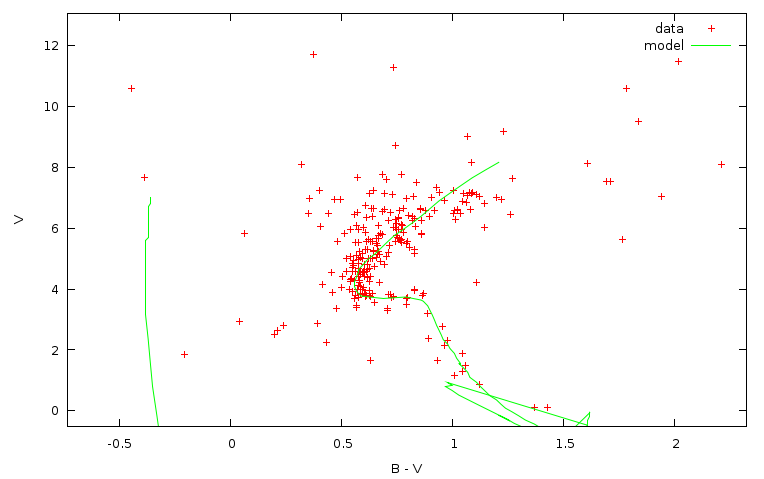

How to create of a colour-magnitude (CMD) diagram which is a photometric equivalent of the Hertzsprung-Russel diagram.
Open cluster M 67 is an old galactic cluster with a differently evolved stars which covers wide range of colour indexes. All stars are approximately same old, but due to its different initial masses and the fact that heavy stars gets older quickly, we are observing the cluster members in different stages of evolution.
A sample data are available as munipack-data-m67.tar.gz. Use commands
$ cd /tmp $ tar zxf munipack-data-m67.tar.gz
to unpack it to a desired directory. We will assume that the sample data are unpacked to /tmp directory as /tmp/munipack-data-m67.
The sample data has been acquired at MonteBoo Observatory by group of author's students "Hrošátka". The flat-fields by ChM. Quality of the observation is poor due to a light pollution by our urban neighbourhood.
To get CMD, follow these points:
$ munipack dark -o d7.fits d7_*.fits $ munipack dark -o d30.fits d30_*.fits $ munipack flat -o fB.fits -dark d7.fits flat_*B.fits $ munipack flat -o fV.fits -dark d7.fits flat_*V.fits $ munipack flat -o fR.fits -dark d7.fits flat_*R.fits $ munipack phcorr -dark d30.fits -flat fB.fits m67_*B.fits $ munipack phcorr -dark d30.fits -flat fV.fits m67_*V.fits $ munipack phcorr -dark d30.fits -flat fR.fits m67_*R.fits
$ munipack find -th 10 -f 6 m67_*.fits $ munipack aphot m67_*.fitsWarnings like:
Object at coordinates: 739.055908 94.7188416
Are you sure your bad pixel thresholds are all right?
If so, then you need a larger outer sky radius.
8 20 1762 84700.0000 3.39999995E+38
are reported for stars near of border (when aperture lie outside
of image) and can be safety ignored.
$ munipack cone -r 0.2 --magmax 14 -- 132.8 11.8
$ munipack astrometry -c cone.fits m67_*.fits
$ munipack kombine --rcen 132.8304 --dcen 11.7771 -o m67_B.fits m67_*B.fits $ munipack kombine --rcen 132.8304 --dcen 11.7771 -o m67_V.fits m67_*V.fits $ munipack kombine --rcen 132.8304 --dcen 11.7771 -o m67_R.fits m67_*R.fits
$ munipack find -th 10 -f 6 m67_?.fits $ munipack aphot m67_?.fits
At this point, data are uncalibrated in magnitudes, but can be used directly, if no calibration source is available. The shape of final diagram will be shifted alongside both axis.
The files M67_*_MAG.fits contains the table, which can be matched and visualised by topcat (Virtual Observatory software).
| α [J2000] | δ [J2000] | instrumental magnitude | std. deviation |
|---|---|---|---|
| 132.8228301 | 11.7562805 | 7.62841 | .00036 |
| … | … | … |
A photometry calibration offers determination of astrophysical characteristics of clusters. The calibration depends on availability of already known calibration stars. We will take stars by UCAC4 catalogue, notwithstanding the photometry accuracy is only about ten percents.
$ munipack cone -r 0.2 --magmax 14 --Johnson-patch -o phcal_cone.fits -- 132.8 11.8
$ munipack phcal --photsys-ref Johnson -f B --area 0.3 --col-mag Bmag \
--col-magerr e_Bmag -c phcal_cone.fits m67_B.fits
$ munipack phcal --photsys-ref Johnson -f V --area 0.3 --col-mag Vmag \
--col-magerr e_Vmag -c phcal_cone.fits m67_V.fits
$ munipack phcal --photsys-ref Johnson -f R --area 0.3 --col-mag Rmag \
--col-magerr e_Rmag -c phcal_cone.fits m67_R.fits
The calibration utilises conversion of Gun's r,i magnitudes on data in Johnson R filter, and determines the conversion. Another source of calibrated magnitudes can be used, if the magnitudes are stored in a FITS file.
Final results can be compared with models tabulated in the article Theoretical isochrones from models with new radiative opacities, Bertelli G., Bressan A., Chiosi C., Fagotto F., Nasi E, Astron. Astrophys. Suppl. Ser. 106, 275 (1994). Tables can be downloaded here: ftp://cdsarc.u-strasbg.fr/pub/cats/J/A+AS/106/275. Alternatively, isochrone models are also available via topcat (look for BaSTI).

The models can be easy plotted and one can determine basic astrophysical characteristics of M 67 open cluster:
This is the outline of the real method used to determine the parameters of clusters in astrophysics. The fitting of the main sequence and the turning point gives an age estimation, at least as wishful thinking.
The presented method is focused on use of Munipack. Therefore we are ignoring some astrophysical difficulties:
Photometry calibration, Photometric System Transformation, Photometry Format, m67.sh